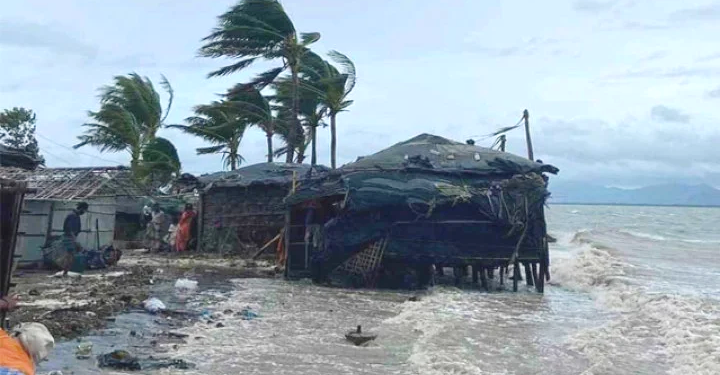Md. Hasanur Rahman Tanzir : Cyclone Remal raged on the coast for a long time, although it did not take a terrible form in the beginning. In 2009, Ayala went on a rampage for about 30 hours. As Remal had an influence there for about 40 hours, it caused more damage to the coastal people than Aila or Amphan. Damage is especially high in fish enclosures and agricultural land. People in the southern part of the country may have to endure the wounds of Remal for a long time.
Recently, in a press conference at the Secretariat, State Minister for Disaster Management and Relief Mohibbur Rahman said that 37 lakh 58 thousand people of the coastal area have been affected by Cyclone Rimal. 35 thousand houses were completely destroyed, and about 1 lakh 15 thousand houses were partially damaged. Later, the state minister said that 18 people died. Cyclone Rimal has caused damage equivalent to Tk 6,880 crore in 20 districts. Meanwhile, an online media report has highlighted the overall situation and damage.
Agricultural damage: A preliminary report of the overall agricultural damage of the agriculture department has revealed that the impact of Cyclone Remal has caused a crop damage of Tk 508 crore 97 lakh 72 thousand only in the coastal Barisal region. About one lakh 73 thousand 491 farmers are affected by this. Cyclone Remal has primarily affected agriculture in 48 districts. Six districts of coastal Barisal region and four districts of Khulna region, Noakhali, Laxmipur and Cox’s Bazar of Chittagong region have been affected at a significant rate.
Geographically, Bangladesh is prone to disasters and has to deal with cyclones that occur every year. So that the most affected are the coastal people of the southern part of the country. In addition to loss of life in these disasters, they are suffering severe economic losses, which take years to recover. Even after blocking the Sundarbans as a shield, the damage is not less.
The recent Cyclone Remal has caused a lot of inundation and crop damage. There is a risk of long-term damage. Earlier, after cyclones like Sidor, Aila, Amphan, the coastal areas suffered from severe fresh water shortage, various water borne diseases, salinity effect on agricultural land, and waterlogging for a long time. These problems are also appearing later on Remal. Along with the government, private development organizations come forward to solve these crises. The stakeholders are emphasizing on sustainable embankment to overcome these crises in the long term.
Most affected Patuakhali: Cyclone Remal’s path was over Patuakhali’s Khepupara. As a result, the amount of damage in this district is slightly higher. Three people were killed. 3 lakh 38 thousand people were affected.
Besides, dams, fisheries, agriculture, education, roads and power sectors have suffered huge damage. The loss in agriculture is 26 crore 21 lakh rupees. The loss in the fisheries sector is 28.69 million rupees. Besides 20 crores in embankment, 7 crores 23 lakhs in forest area, 3 crores 6 lakhs deep tube wells and 8 crores sanitary toilets have been damaged. Patuakhali District Relief and Rehabilitation Officer Suman Debnath informed this information. Patuakhali has suffered a lot in agriculture. In many parts of the district, water still accumulates in the agricultural land. Thousands of farmers are facing huge losses. The loss of ravi seeds has been especially high.

Entire southern region affected: Residents of the southern region say that weak embankments have broken and dams have overflowed, flooding localities. Livelihoods are affected. Marginalized people are becoming economically weaker due to the violence of cyclones every year. The effect of which is long-term. Storm surges are 8 to 12 feet high. Compared to that, the height of the river dams in this area is low. Sea and river water is rising. As a result, water easily overflows the dam. But the Water Development Board is not making any long-term plans for dam renovation. Mahtab Hossain, a resident of Barisal’s Uzirpur, said, “Due to the impact of Cyclone Remal, the fish cages and water barges were damaged and there was a loss of around 10 lakh rupees. There is no situation to turn around from this loss and resume business.’ The same situation is spread across the country’s vast areas of Khulna, Bagerhat, Bhola, Barguna, Pirojpur, Jhalkathi, Barisal, Noakhali. Many crop lands in these areas are still under water.
Khandkar Yasir Arefin, Deputy Commissioner of Khulna said, “The damage that is happening every year, the flood is a natural thing. We have nothing to do here. It is not possible to compensate the people only with relief. We have been informing these things centrally. Let’s see what the government is considering. We think a permanent dam would be a solution. This will reduce the damage to the agricultural economy.
Morrelganj upazila has flooded most areas in Bagerhat. Flooding of three to five feet has occurred in this upazila. In addition to crop land, numerous fish enclosures were damaged in the area. Farmers in the area said that they had never seen such a prolonged flood before. Fish and agriculture are over.
A local farmer Sharif, a resident of Bagerhat’s Morrelganj, said, “After three days, the water came down from the crop field. Two days after the cyclone, the crop fields were submerged in tidal water. The flood water from these three rivers caused more damage. A big fish cage of our two brothers has also been destroyed.
Wounds across the Sundarbans: The Sundarbans bear the brunt of any storm, including Remal, every year. The forest is damaged while preventing. Before the wound heals, another disaster strikes like a cyclone. This time the Sundarbans sank under several feet of water due to heavy rain due to Remal. Hundreds of animals died. There is damage to plants. The forest department has also been affected in various ways.
Mihir Kumar Do, Conservator of Forests (CF) of Khulna region, said that the rampage of Remal and the flood have caused a lot of damage to the wildlife of the Sundarbans. Apart from extensive loss of vegetation, various forest offices, patrol boats, tin sheds, solar panels and infrastructure of the forest department have been damaged. At this time, the jetty and pond of the office ghat of Cuttack Sanctuary have disappeared into the Bay of Bengal. The cyclone has blown away the tin sheds of 25 patrol outposts including Dubla, Katka, Kachikhali, Bagi and various forest offices. After Sidor and Aila, 1.75 lakh people were affected in Barisal division by super cyclone Amphan, 2.2 lakh 35 thousand people were affected in Rimal. The official death toll in Cyclone Sidr in 2007 was 3,363. However, the number of dead is 10,000, according to the Red Crescent. 11 lakh 787 hectares of land immediately became unfit for cultivation due to the breach of dam in Sidr. 17 lakh 78 thousand 560 poultry and cattle died. The length of the road that was washed away by the flood and destroyed was 8 thousand 75 km.
According to information from the Bangladesh Environment Movement, 25 people were killed when Cyclone Aila hit, and the damage was Tk 220 million. Cyclone Amphan, which hit in 2020, caused a loss of around 1100 crore rupees. And the amount of loss in Rimal is about seven thousand crore rupees. Sharif Jamil, coordinator of Water Keepers Bangladesh, said, ‘The coastal areas of the southern part of the country are the most vulnerable to disasters due to various reasons including climate change. Since the last 20 years, the risk of life and livelihood has increased in that region due to one disaster after another including Ayla, Amphan, Yas. Becoming financially destitute. As a result, common people are forced to leave the area. Cities are under increasing pressure due to immigration. The number of people in poverty is increasing. Its impact is falling on the economy of the entire country.
This environmentalist said, “There is no long-term integrated disaster management project in this area.” Therefore, a specific development plan should be taken for the development of the coast. A separate budget should be allocated for the implementation of that plan.
In this regard, the Secretary of the Ministry of Disaster Management and Relief said. Kamrul Hasan said, ‘The disaster that happened this time is category-4. Number ten was the danger signal. It has rained to save energy. Crops have been destroyed, summer vegetables have been destroyed. He further said, “Natural disasters cannot be stopped. All we can do is adapt. And what we do after the disaster is mitigation. We are now in a pro-active state due to adaptation. The amount of damage that used to be caused by various disasters, now that damage is much less than before.
hr.tanzir@gmail.com




















